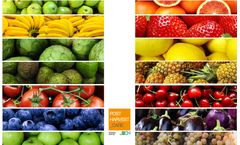Refine by
Mango Articles & Analysis
25 articles found
Water is present in everything we eat. It often goes unseen, yet it is essential for growing, processing, transporting, and preparing every ingredient that reaches our tables. From a cup of coffee to a fresh salad or a plate of rice, water is at the heart of global gastronomy. Today, in an increasingly interconnected world, this relationship between water and food takes on new dimensions, ...
The Ripening chamber is used to ripen fruits such as bananas, mangoes, and papayas. There are many ways to ripen fruits, but the most common method is “ethylene ripening”. Ethylene is sufficient to naturally stimulate immature fruits.Climacteric fruits such as bananas, mangoes, and papayas are used to ripen using ethylene gas in a closed room under controlled ...
The Northern Tonle Sap Basin (NTSB) in the center-west part of Cambodia is home to one of the region's most important agricultural systems, where farmers produce mainly cashew, mango, rice, and vegetables. The area is also severely threatened by climate change disruption as temperatures have steadily increased by a total of 0.8C° since 1950. ...
Thus, to eradicate these problems and strengthen Andhra’s agriculture, SankalpTaru is working out an action plan of planting varied fruit-bearing saplings on the lands of poor rural farmers by implementing horticulture farming technique. Species planted: Mango and Guava Regions covered: Anantapur district ...
To support the distressed farmers, SankalpTaru has started Project Pasumai Tamil Nadu, our new initiative to lend a helping hand to farmers by planting fruit bearing trees like Sapota, Pomegranate, Guava, Mango, Custard apple, Amla, Lemon, and Coconut on their lands. With this project we are trying to strengthen the options of livelihoods of farmers while also enriching greenery ...
The most common examples of climacteric fruit are: apples, pears, tomato, custard apple, avocado, banana, mango, papaya, kiwi,.... Non-climacteric fruits, on the other hand, undergo a gradual and continuous ripening process. ...
“We can grow anything: even bananas, potatoes and mangoes. You name it, we can grow it.” Unlike fields, Seven Steps To Heaven can create the ideal environment. ...
Tropical mango diced, in the sunshine, a healthy fruit salad in the garden, or an apple for a rainy day. ...
LAI for: Apples can be between 1.5 and 5. Peaches can be 7 to 10. Mangoes is, on average, 2.94 and can lie between 1.18 and 4.48. Oranges is high, between 9 and 11. ...
LAI for: Apples can be between 1.5 and 5. Peaches can be 7 to 10. Mangoes is, on average, 2.94 and can lie between 1.18 and 4.48. Oranges is high, between 9 and 11. ...
Imagine that 3.21 pounds of fresh mangoes were consumed in the US per person in 2017. As well as, 2.71 pounds of peaches and 7.75 pounds of pineapples per person were consumed. ...
This included avocado (Persea americana), corn (Zea mays), guava (Psidium guajava), mango (Mangifera indica), sorghum (Sorghum bicolor), sugar cane (Saccharum sp.), and tiger’s claw (also referred to as wiliwili; Erythrina variegata). ...
A key issue that Blue skies had to overcome was the short storage period of ready to eat Mangoes. Prior to using Bioconservacion Air Purification Solutions, The regular storage period of Mangoes was ONE week at 6-8ºC. Once using Bioconservacion Air Purification Solutions, extend storage period of Mangoes was improved by one to TWO weeks at ...
A key issue that Blue skies had to overcome was the short storage period of ready to eat Mangoes. Prior to using Bioconservacion Air Purification Solutions, The regular storage period of Mangoes was ONE week at 6-8ºC. Once using Bioconservacion Air Purification Solutions, extend storage period of Mangoes was improved by one to TWO weeks ...
In general, crops grown for export or even larger regional markets fetch much higher prices than do crops grown for local markets; most farmers therefore would rather grow apples or mangoes, which are more commercially popular, than indigenous crops like baobab. ...
ByEnsia
Australian mango growers and exporters are sending their first big shipments to the US this season, with plans to export between 100 and 200 tonnes in the coming months. This compares to the first export season in February 2015, which saw 5.5 tonnes of mangoes shipped to the US from two growers. ...
Agricultural waste biomass generated from agricultural production and food processing industry are abundant, such as durian peel, mango peel, corn straw, rice bran, corn shell, potato peel and many more. ...
Dark green leafy vegetables and yellow-fleshed fruit such as pumpkins and mangoes are recommended to correct vitamin A deficiency, a major cause of blindness in African children. ...
June is the end of the hot and dry season in Senegal. More auspiciously, it is peak mango season. As I drove north from the capital of Dakar with a team from the Wetlands International Africa office, mango sellers blanketed the roadside selling the best mangoes I’d ever tasted. ...
Pre-decomposed (15 days) mango leaf litter with cowdung in 50:50 (wt/wt) was subjected to vermicomposting using Perionyx ceylanensis for 60 days. ...















